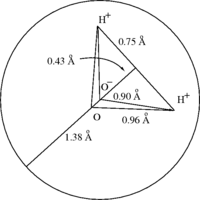BF model of water: Difference between revisions
Jump to navigation
Jump to search
m (BF moved to BF model of water) |
Carl McBride (talk | contribs) mNo edit summary |
||
| (4 intermediate revisions by the same user not shown) | |||
| Line 1: | Line 1: | ||
{{Stub-water}} | {{Stub-water}} | ||
The [[Bernal]] and [[Sir Ralph Howard Fowler FRS| Fowler]] ( | [[Image:Bernal_and_Fowler_model.png|thumb|200px|right|Schematic diagram of the geometry of the BF model (adapted from Fig. 10 of Ref. 1).]] | ||
designed to study liquid [[water]]. | The '''BF''' ([[Bernal]] and [[Sir Ralph Howard Fowler FRS| Fowler]]) model <ref>[http://dx.doi.org/10.1063/1.1749327 J. D. Bernal and R. H. Fowler "A Theory of Water and Ionic Solution, with Particular Reference to Hydrogen and Hydroxyl Ions", Journal of Chemical Physics '''1''' pp. 515-548 (1933)]</ref> is one of the original models | ||
designed to study liquid [[water]]. It is worth noting that this model bears a striking resemblance to the geometry of the [[TIP4P model of water]], which was proposed in 1983, and has been extremely popular ever since. | |||
==References== | ==References== | ||
<references/> | |||
'''Related reading''' | |||
*[http://dx.doi.org/10.1088/1742-6596/57/1/004 John L. Finney "Bernal and the structure of water", Journal of Physics: Conference Series '''57''' pp. 40-52 (2007)] | |||
[[category:water]] | [[category:water]] | ||
[[category:models]] | [[category:models]] | ||
Latest revision as of 12:42, 6 July 2010

The BF (Bernal and Fowler) model [1] is one of the original models designed to study liquid water. It is worth noting that this model bears a striking resemblance to the geometry of the TIP4P model of water, which was proposed in 1983, and has been extremely popular ever since.
References[edit]
Related reading